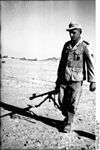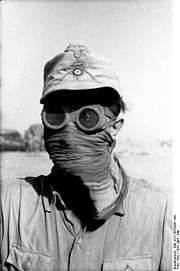90th Light Infantry Division (Wehrmacht)
| 90th Light Infantry Division | |
|---|---|
|
German infantryman seeking protection from desert dust: Western Desert: 1942. | |
| Active |
August 1941 – May 1943 July 1943 – April 1945 |
| Country |
|
| Branch | Heer |
| Type | Infantry |
| Role |
Light infantry Panzergrenadier Grenadier |
| Size | Division |
| Engagements |
North African Campaign Italian Campaign |
| Insignia | |
| First insignia of 90th Light Div. |
|
| Second insignia of the 90th Light Division l. |
|
The 90th Light Infantry Division was a light infantry division of the German Army during World War II that served in North Africa as well as Sardinia and Italy. The division played a major role in most of the actions against the British Eighth Army in the Western Desert Campaign and eventually surrendered to the Allies in the final stages of the Tunisia Campaign in May 1943. It was re-constituted later in 1943 and deployed to Sardinia and when the expected Allied invasion of Sardinia failed to materialise, the division was moved to Italy. It was engaged in actions against the Allies in Italy from 1943 to September 1944 when the division was listed as "destroyed" south of Bologna.
History
Formation
On 26 June 1941, the OKH ordered the creation of a Division HQ staff for Kommando zbV Afrika in Germany. The planned division was intended for deployment to Africa to re-balance, and add infantry troops to the DAK deployed in the Western Desert. The formation headquarters was sent to Africa between late August and mid September 1941 and deployed to command the Sollum area with the first units (347th Infantry Regiment and 300th Special Services "Oasis" Battalion) being attached on 15 October 1941.[1] On 20 October more units were attached (155th Inf Regt, 900th Engineer Battalion and 605th Anti Tank battalion) and the division troops were expanded to full strength with the division becoming known as Division z.b.V. Afrika [1][Note 1]
The subordinated 288th Special Service Unit, originally known as Sonderverband 288 was a regimental sized, special operations unit consisting of sub-units with various combat specialties including mountain and desert warfare, night operations and infiltration. This unit was formed in Potsdam in 1941 from specialist soldiers with previous experience in the deserts of the Middle East and North Africa.[2] Two battalions from Sonderverbande 288 and one locally recruited Arab battalion were later amalgamated to form the 155th Rifle (later Panzergrenadier) Regiment within the division.[3] The 361st Regiment contained 300 legionnaires were had been selected by the Germans from the French Foreign Legion; brought about by the Wehrmacht's incessant need for additional troops.[2][3]
Training was completed in the Bardia area and the division was earmarked by Rommel to lead the attack on Tobruk. On 28 November 1941, the formation was renamed 90.leichte Afrika Division (90th Light Africa Division).[4] Through its five-year existence, it was re-designated several times, although always known colloquially as the Africa Division, being the only German combat division to have been largely raised in Africa itself.

African theater and surrender in Tunisia
It fought for the remainder of the North African Campaign, finally surrendering to the Allies in the end of the Tunisia Campaign in May 1943. It was regarded apparently by the 2nd New Zealand Division, commanded by Lieutenant-General Sir Bernard C. Freyberg VC, as their special foe, as the two formations faced each other on several occasions. General Graf von Sponecks 90th Light Division insisted on giving up to the New Zealanders, their doughty adversaries of two years standing.[5]
Sardinia and destruction in Italy
As with the other units of the Afrika Korps, replacement units were quickly raised from available troops stationed in Western Europe. As such, the Africa Division was reconstituted as the 90th Panzergrenadier Division in Sardinia during July 1943. Evacuated from Corsica with the Sturmbrigade Reichsführer SS to the Italian mainland in October 1943, the division appeared opposite both the Americans and British as they pushed north. It was then very nearly wiped out in the bitter fighting with the 1st Canadian Infantry Division along the Moro River in late November 1943. A short time later it was withdrawn into reserve at Frosinone and redesignated 90th Grenadier Division (Motorized). While still rebuilding, it was deployed piecemeal along the front in response to the Allies spring offensive in 1944 to serve as a rearguard while the balance of the German units in southern Italy fell back to the Winter Line. Shifted southeast from the Franco-Italian border in September 1944, 90th Grenadier was finally listed as destroyed in the fighting south of Bologna. The remainder of its personnel surrendered to the Brazilian Expeditionary Force (FEB) in Italy in April 1945.
Lineage and Organisation
The division formed part of the Afrika Korps during its deployment to North Africa.
| Division z.b.V. Africa (African "Special Service" Division) [3] | Period in existence: | July 1941 –28 November 1941 |
| Commanders: | Major General Max Sümmermann: 17 Jul 41 – 28 Nov 41 | |
| 155th Rifle Regiment[6] | 361st Africa Regiment[6] | 255th Infantry Regiment [6] |
| 347th Infantry Regiment [6] | 300th Special Use 'Oasis' Battalion [6] | 605th Anti Tank Battalion [6] |
| 900th Engineer Battalion (mot) [6] | ||
| 90th Light African Division [3] | Period in existence: | 28 November 1941 [3] – March 1942 |
| Commanders: | Major General Max Sümmermann: 28 Nov 41 – 10 Dec 41[Note 3] | Colonel Johann Mickl: 11 - 27 Dec 41 |
| Major General Richard Veith: 28 Dec 41 – March 42 | ||
| 155th Infantry Regiment | 200th Infantry Regiment | 361st Africa Infantry Regiment |
| 361st Artillery Battalion | 190th Anti Tank Battalion | |
| 90th Light Division | Period in existence: | March 1942 – May 1943 |
| Commanders: | Major General Richard Veith: March 42 - 28 Apr 42 | Major General Ulrich Kleemann: 29 Apr 42 - 14 Jun 42 |
| Colonel Werner Marcks: 14 Jun 42 - 18 Jun 42 | Colonel Erwin Menny: 18 - 19 Jun 42 | |
| Colonel Werner Marcks: 19 - 21 Jun 42 | Major General Ulrich Kleemann: 21 Jun - 8 Sep 1942 | |
| Major General Hermann-Bernhard Ramcke: 8 - 17 Sep 1942 | Colonel Hermann Schulte-Heuthaus: 17 - 22 Sep 1942 | |
| Lieutenant General Theodor Graf von Sponeck: 22 Sep 42 - 12 May 1943 | Lieutenant General Carl-Hans Lungershausen: May 1943 | |
| 155th Light Infantry Regiment (mot)[7] | 200th Light Infantry Regiment[7] | 361st Light Infantry Regiment[7] |
| 288th Special Service Regiment[7] | 190th Panzer Battalion [7] | 361st Artillery Battalion (mot)[7] |
| 190th Artillery Regiment (mot)[7] | 580th Panzer Reconnaissance Battalion[7][Note 5] | 190th Anti Tank Battalion (mot)[7] |
| 605th Anti Tank Battalion[7] | 900th Engineer Battalion (mot)[7] | 1x Company 190th Panzer Signals Battalion[7] |
| 606th Anti Aircraft Battalion[7] | 90/190th Field Replacement Company[7][Note 6] | 190th Supply Regiment[7] |
| 90th Panzergrenadier Division | Period in existence: | July 1943 – November 1943 |
| Commanders: | Lieutenant General Carl-Hans Lungershausen: July - November 1943 | |
| 155th Panzergrenadier Regiment | 200th Panzergrenadier Regiment | 361st Panzergrenadier Regiment |
| 190th Panzer Battalion | 190th Artillery Regiment | 242nd Sturmgeschütz Battalion[Note 7] |
| 1st/190th Antitank Company[Note 8] | ||
| 90th Grenadier Division | Period in existence: | November 1943 – May 1945 |
| Commanders: | Lieutenant General Carl-Hans Lungershausen: Nov - 20 Dec 43 | Lieutenant General Ernst-Günther Baade: Dec 43 – Dec 44 |
| General der Panzertruppe Gerhard von Schwerin: Dec 44 – 1 Apr 45 | Major General Heinrich Baron von Behr: 1 - 28 Apr 45 | |
| Unknown | ||
Notes, citations and references


Notes
- ↑ The abbreviation z.b.V. stands for zur besonderen Verwendung, which translates as "for a special use" in English.
- ↑ Order of battle as at 10 November 1941
- ↑ Killed in action
- ↑ Order of battle as at 10 May 1942
- ↑ Later assigned to 21st Panzer Division
- ↑ Was assigned to division but was being formed in Germany
- ↑ Assigned in October 1943
- ↑ Initially, only one company, from October 1943 full battalion was assigned
Citations
- 1 2 Battistelli (2006), pp25-26
- 1 2 Pipes, Jason. "Feldgrau.com - research on the German armed forces 1918-1945". 90.leichte-Afrika-Division. Retrieved 5 November 2013.
- 1 2 3 4 5 Littlejohn, David (1979). Foreign Legions of the Third Reich: Volume 1: Norway, Denmark and France. San Jose: R. James Bender. p. 199. ISBN 0912138173.
- ↑ Battistelli (2006), pp26
- ↑ Richard Collier. 1977 Time Life Books
- 1 2 3 4 5 6 7 Battistelli, Pier Paulo (2006). Rommel's Africa Korps. Oxford: Osprey. p. 28. ISBN 9781841769011.
- 1 2 3 4 5 6 7 8 9 10 11 12 13 14 15 Battistelli(2006) pp.38-39
References
- Battistelli, Pier Paulo (2006). Rommel's Africa Korps. Oxford: Osprey. ISBN 9781841769011.
- Littlejohn, David (1979). Foreign Legions of the Third Reich: Volume 1: Norway, Denmark and France. San Jose: R. James Bender. ISBN 0912138173.
- Mehner, Kurt (1993). "Die Deutsche Wehrmacht 1939–1945". Militair-Verlag Klaus D. Patzwall. Norderstedt, Germany. (no ISBN)

